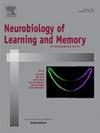Frustrative nonreward, sucrose consumption, and the basal ganglia: Role of chemogenetic activation of projections from the nucleus accumbens to the globus pallidus internus, globus pallidus externus, and ventral pallidum
IF 1.8
4区 心理学
Q3 BEHAVIORAL SCIENCES
引用次数: 0
Abstract
Mammals experience negative emotions after the unexpected reduction in reward magnitude—called frustrative nonreward (FNR). The neurobiological mechanisms activated in response to unexpected reward downshift could shed light on loss-induced anxiety, conflict, mood, and physical pain. Experiment 1 examined the role of three basal ganglia (BG) pathways in the adjustment to unexpected sucrose downshifts. A double-infection chemogenetic procedure was used to activate neurons in the nucleus accumbens (NAc) that project to the globus pallidus externus (GPe), globus pallidus internus (GPi), or ventral pallidum (VP) during a 32-to-2% sucrose downshift. Activation of the NAc-to-GPe pathway had no observable effects on licking during reward downshift, whereas activation of either the NAc-to-GPi or NAc-to-VP pathways caused significant consummatory suppression. Chemogenetic activation of the NAc-to-GPi and NAc-to-VP pathways also yielded increased consummatory suppression in animals exposed to either 2% sucrose (Experiment 2) or 32% sucrose (Experiment 3) in the absence of a sucrose downshift. These effects were accompanied by no evidence of motor dysfunction in the open field and a nonsignificant trend toward a decrease in sucrose palatability, particularly with a choice between 2% sucrose and water. However, preliminary observations show that licking suppression after CNO injections also enhanced activity in the conditioning box during access to 32% sucrose and relative to vehicle injections. Thus, these BG pathways regulate consummatory behavior in different ways, but whether BG dysfunction influences the behavioral response to unexpected reward downshifts remains to be established.
挫折性无奖赏、蔗糖消耗和基底神经节:伏隔核向内苍白球、外苍白球和腹侧苍白球投射的化学激活的作用
哺乳动物在奖励量意外减少后会经历负面情绪,这被称为挫折性无奖励(FNR)。意想不到的奖励下降反应激活的神经生物学机制可以揭示损失引起的焦虑、冲突、情绪和身体疼痛。实验1考察了基底节区(BG)的三条通路在调节非预期的蔗糖下降中的作用。采用双重感染化学发生程序,激活伏隔核(NAc)中的神经元,这些神经元在32- 2%蔗糖降速期间投射到外白球(GPe)、内白球(GPi)或腹侧白球(VP)。在奖赏下降过程中,nac - gpe通路的激活对舔舐没有明显的影响,而nac - gpi或nac - vp通路的激活则引起了显著的完满抑制。在没有蔗糖降速的情况下,暴露于2%蔗糖(实验2)或32%蔗糖(实验3)的动物,nac - gpi和nac - vp途径的化学发生激活也产生了更高的终性抑制。这些影响并没有伴随着空地运动功能障碍的证据,也没有明显的趋势表明蔗糖的适口性下降,特别是在2%蔗糖和水之间的选择。然而,初步观察表明,CNO注射后的舔舐抑制也增强了调节箱在获得32%蔗糖和相对于载体注射时的活性。因此,这些BG通路以不同的方式调节完善行为,但BG功能障碍是否影响对意外奖励下降的行为反应仍有待确定。
本文章由计算机程序翻译,如有差异,请以英文原文为准。
求助全文
约1分钟内获得全文
求助全文
来源期刊
CiteScore
5.10
自引率
7.40%
发文量
77
审稿时长
12.6 weeks
期刊介绍:
Neurobiology of Learning and Memory publishes articles examining the neurobiological mechanisms underlying learning and memory at all levels of analysis ranging from molecular biology to synaptic and neural plasticity and behavior. We are especially interested in manuscripts that examine the neural circuits and molecular mechanisms underlying learning, memory and plasticity in both experimental animals and human subjects.

 求助内容:
求助内容: 应助结果提醒方式:
应助结果提醒方式:


